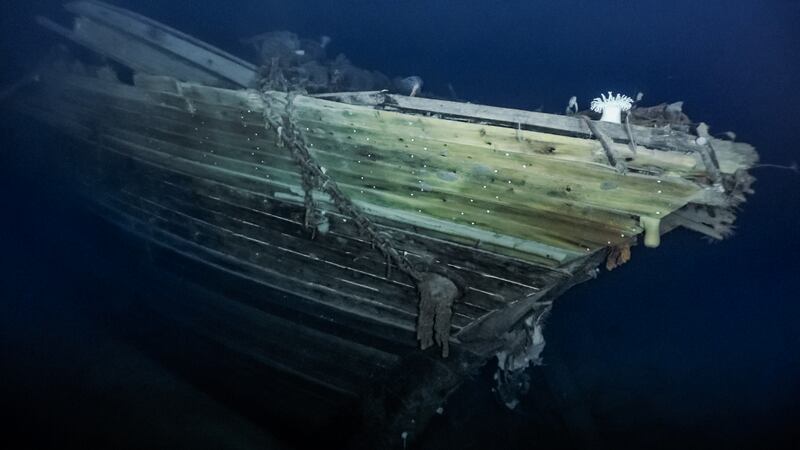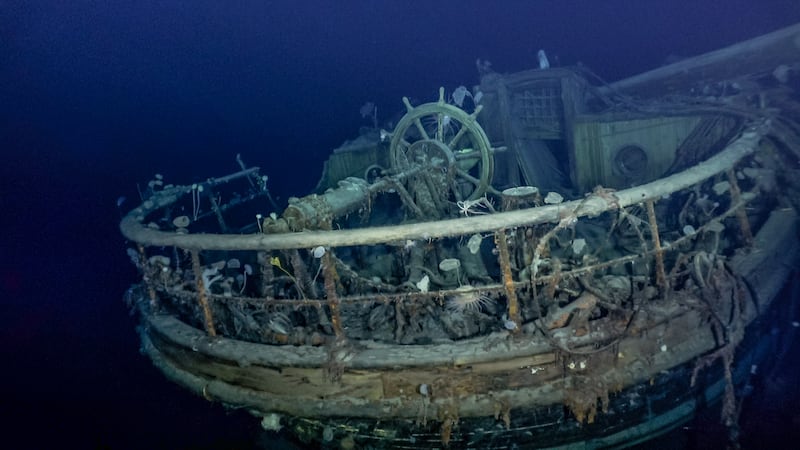Explorer Ernest Shackleton’s polar expedition ended abruptly in 1915 when his ship Endurance froze and sank in a field of ice in the Weddell Sea off the coast of Antarctica. For more than a hundred years, explorers have searched for the vessel, assuming whatever they eventually found would be mostly destroyed after being crushed by the ice that downed it.
The last images of the sinking ship were taken by Shackleton and his 28-strong crew as they escaped, skipping over the ice field as it consumed the Endurance and sent it some 10,000 feet down to the frozen seabed.
And that’s where the Endurance was found over the weekend—with cooking utensils and even clothing still well-preserved, Mensun Bound, a marine archaeologist who is on the Endurance22 discovery expedition that located it, told the BBC. “You can even see the ship’s name — E N D U R A N C E — arced across its stern directly below the taffrail. And beneath, as bold as brass, is Polaris, the five-pointed star, after which the ship was originally named.”

The seasoned explorer told the BBC the discovery of the sunken ship made him emotional. “I tell you, you would have to be made of stone not to feel a bit squishy at the sight of that star and the name above,” he said. “You can see a porthole that is Shackleton’s cabin. At that moment, you really do feel the breath of the great man upon the back of your neck.”
The vessel has been discovered largely intact, its wood perfectly preserved by the icy underwater conditions with even the blue paint and gold five-point star hardly chipped in what preservationists have called astonishing. Because of the icy water, marine life that would generally feed on wood was absent. “Without any exaggeration this is the finest wooden shipwreck I have ever seen—by far,” Bound said. “It is upright, well proud of the seabed, intact, and in a brilliant state of preservation.”

The ship will now be studied using submersible cameras. “It would appear that there is little wood deterioration, inferring that the wood-munching animals found in other areas of our ocean are, perhaps unsurprisingly, not in the forest-free Antarctic region,” polar biologist Michelle Taylor from Essex University told the BBC. “The Endurance, looking like a ghost ship, is sprinkled with an impressive diversity of deep-sea marine life—stalked sea squirts, anemones, sponges of various forms, brittlestars, and crinoids, all filter feeding nutrition from the cool deep waters of the Weddell Sea.”
The discovery expedition was commissioned by Falklands Maritime Heritage Trust and cost more than $10 million, largely paid for by a still-anonymous donor. The discovery crew left on an icebreaker embarked from Cape Town, South Africa, in February, a month after the 100th anniversary of Shackleton’s death.

The sunken vessel was discovered about four miles from where the captain Frank Worsley said it sank. The crew, led by lead scientist Lasse Rabenstein, spent hundreds of hours studying the effects of climate change, researching ice drifts, weather history, and ice thickness to pinpoint where it might be. The scientists also used satellite imagery to map the sea ice from space, according to the Falklands Maritime Heritage Trust press release.
Once they determined a location that was the most likely place the Endurance would be found, they used submersibles with cameras from below and sonar from above to find inconsistencies in the normally smooth ice sheet above the wreckage. Once it was located late last week, they sent down high-resolution cameras to film the wreckage. “We have made polar history with the discovery of Endurance, and successfully completed the world’s most challenging shipwreck search,” the discovery expedition leader John Shears said. “In addition, we have undertaken important scientific research in a part of the world that directly affects the global climate and environment.”
Shackleton’s goal was to document the first land crossing of Antarctica from the Weddell Sea via the South Pole. While he never reached his aspiration, his expedition is one of the most studied survival stories in exploration history. Shackleton’s entire crew survived the ordeal. The men camped on drifting ice for months and, once on open water, used lifeboats to get to Elephant Island. Shackleton left all but five crew members with whom he traveled 800 miles in a lifeboat to reach South Sandwich Islands and eventually a whaling station. He had told the remaining crew members that if he didn’t return by early summer, they should find another way to safety. He eventually sent a ship to rescue to fetch them four months after he left.
“However, it is not all about the past; we are bringing the story of Shackleton and Endurance to new audiences, and to the next generation, who will be entrusted with the essential safeguarding of our polar regions and our planet,” Bound said. The discovery will be part of a documentary to air this fall on History Hit in conjunction with National Geographic. “We hope our discovery will engage young people and inspire them with the pioneering spirit, courage and fortitude of those who sailed Endurance to Antarctica. We pay tribute to the navigational skills of Captain Frank Worsley, the captain of the Endurance, whose detailed records were invaluable in our quest to locate the wreck.”





